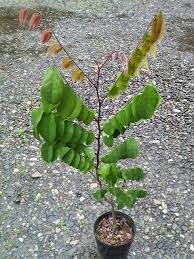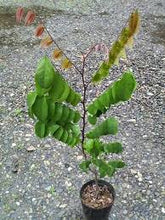Sweet Balimbing / Starfruit Grafted Seedling
Regular price
₱350.00
Sale
Sweet Balimbing Grafted Seedling
(1-2 feet tall)
Family • Oxalidaceae
Scientific names:
Averrhoa acutangula
Averrhoa carambola Linn.
Sarcotheca philippica (Villar) Hallier f.
Common names
Stokes Balimbing (C. Bis., Bik., Sul., Tag.)
Balingbing (Bik., C. Bis.)
Balimbin (Tag.)
Blingbing (Tag.)
Daligan (Ilk.)
Dalihan (Ibn.)
Galañgan (P. Bis.)
Galuran (Ibn.)
Garahan (Bis.)
Garulan (Ibn.)
Malimbin (S. L. Bis.)
Sirinate (Ting.)
Carambola (Span.)
Caramba (Span.)
Chinese gooseberry (Engl.)
Five corners fruit (Engl.)
Five fingers (Engl.)
Foreign peach (Engl.)
Star fruit (Engl.)
Star pickle (Engl.)
DESCRIPTION
Growth Habit: The carambola is a slow-growing, short-trunked evergreen tree with a much-branched, bushy canopy that is broad and rounded. Mature trees seldom exceed 25-30 feet in height and 20-25 feet in spread. In a spot to its liking carambolas make handsome ornamentals. Container grown plants are equally attractive and have the additional advantage of being movable.
Adaptation: The carambola is classified as subtropical because mature trees can tolerate temperatures as low as 27° F for short periods of time with little damage. Like many other subtropicals, however, young plants are more susceptible to frost and can be killed at 32° F. Carambolas can be severely damaged by flooding or prevailing hot, dry winds. The small trees make good container plants.
Botany
Balimbing is a small tree growing to a height of 6 meters or less. Leaves are pinnate, about 15 centimeters long. Leaflets are smooth, usually in 5 pairs, ovate to ovate-lanceolate, the upper ones about 5 centimeters long and the lower ones smaller. Panicles are small, axillary and bell-shaped, 5 to 6 millimeters long. Calyx is reddish purple. Petals are purple to bright purple, often margined with white.
Fruit is fleshy, green to greenish yellow, about 6 centimeters long, with 5 longitudinal, sharp and angular lobes. Seeds are arillate.
Foliage: The spirally arranged, alternate leaves are 6 - 10 inches long, with 5 - 11 nearly opposite, ovate-oblong leaflets that are 1-1/2 to 3-1/2 inches in length. They are soft, medium-green, and smooth on the upper surface, faintly hairy and whitish on the underside. The leaflets are sensitive to light and more or less inclined to to fold together at night or when the tree is shaken or abruptly shocked.
Flowers: The fragrant, pink to lavender flowers are 3/8 inch in diameter, perfect, and borne in clusters in axils of leaves on young branches, or on older branches without leaves. There are several flushes of bloom throughout the year.
Fruit: Carambola fruits are ovate to ellipsoid, 2-1/2 to 5 inches (6 to 13 cm) in length, with 5 (rarely 4 or 6) prominent longitudinal ribs. Slices cut in cross-section are star shaped. The skin is thin, light to dark yellow and smooth with a waxy cuticle. The flesh is light yellow to yellow, translucent, crisp and very juicy, without fiber. The fruit has a more or less oxalic acid odor and the flavor ranges from very sour to mildly sweet. The so-called sweet types rarely have more than 4% sugar. There may be up to 12 flat, thin brown seeds 1/4 - 1/2 inch long or none at all. Seeds lose viability in a few days after removal from fruit.
CULTURE
Location: Carambolas do best in a frost-free location. They are tolerant of wind except for those that are hot and dry. The tree needs full sun.
Soils: The carambola is not too particular as to soil, but will grow faster and bear more heavily in rich loam. It prefers a moderately acid soil (pH 5.5 - 6.5) and is sensitive to waterlogging. The plant often becomes chlorotic in alkaline soils.
Irrigation: The carambola need moisture for best performance. This means regular watering during the summer months and must be watered even in winter during dry spells.
Fertilization: In soils of low fertility young trees should receive light applications every 60 to 90 days until well established. Thereafter, they should receive one or two applications a year in deep soils or three or more applications in shallow soils where nutrients are lost by leaching. Application at the rate of 2 lbs per year for every inch of trunk diameter is suggested. Fertilizer mixtures containing 6-8% nitrogen, 2-4% available phosphoric acid, 6-8% potash and 3-4% magnesium are satisfactory. The tree is prone to chlorosis in many western soils but responds to soil and foliar
application of chelated iron and other micronutrients.
Pruning: Carambolas seldom need pruning.
Pests and Diseases: No serious diseases are known to be of sufficient importance to require control measures. The fruit is subject to fruit fly, fruit moths and fruit spotting bugs in those areas having these infestations.
Propagation: The carambola is widely grown from seed though viability lasts only a few days. Only plump, fully developed seed should be planted. Veneer grafting during the time of most active growth gives the best results. Healthy, year-old seedlings of 3/8 - 3/4 inch diameter are best for rootstocks. Graft-wood should be taken from mature twigs on which leaves are still present and, if possible, the buds are just beginning to grow. Cleft Grafting of green budwood is also successful. Top-working of older trees has been done by bark grafting. Air Layering is less successful than grafting. The roots develop slowly, and percentage of success often is low. Trees are small and rather weak when propagated by this method.
Harvest: Fruit best when ripened on the tree, but will ripen slowly if picked before fully ripe. Green or ripe fruits are easily damaged and must be handled with great care. Ripe carambolas are eaten out-of-hand, sliced and served in salads or used as a garnish. They are also cooked in puddings, tarts, stews and curries.
Parts used
Leaves, flowers, seeds, fruit.
Uses
Edibility / Culinary / Nutritional
- Edible fruit is a source of iron (low in calcium) and vitamins B and C, oxalate and potassium.
- Because of high potassium content, the fruit should be excluded from the diets of patients with renal failure.
- In the Philippines, the fruit is eaten with or without salt; the juice used for seasoning.
- Fruit used in making pickles and sweets.



